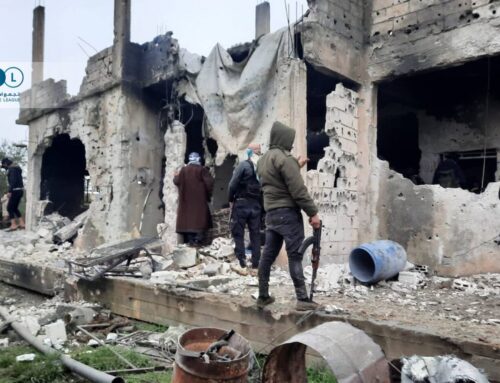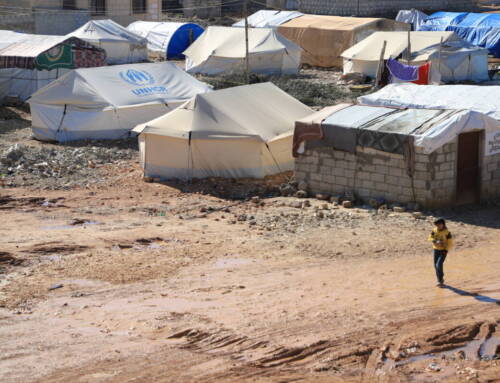Eyes on the sky: Syrian monitors warn civilians of impending airstrikes
The moment he sees a Syrian fighter jet take off […]
14 July 2016
The moment he sees a Syrian fighter jet take off from the Hama Military Airport, located on the western outskirts of Hama city, Abu Sateef al-Khitabee grabs his walkie-talkie. He begins relaying the aircraft’s trajectory to a small team of activists spread out across the province.
Al-Khitabee is the founder of the 80th Monitoring Unit, which tracks the movement of Syrian regime and Russian military aircraft in order to warn civilians and rebel fighters of impending airstrikes and barrel bomb attacks.
“Once the regime started using air power against civilians, we began to track aircraft and warn civilians of coming airstrikes,” al-Khitabee tells Syria Direct’s Bahira al-Zarier.
The 80th Monitoring Unit is one of more than 90 similar units operating across Syria working to warn civilians of what has become a near-daily occurrence—indiscriminate attacks from the skies.
“Almost every civilian home in Hama has a walkie-talkie to hear the monitoring units’ updates,” the chief of the 20th Monitoring Unit, also located in Hama province, tells Syria Direct.
“They listen every minute of the day.”
Abu Sateef al-Khitabee, the founder of the 80th Monitoring Unit
Q: Could you explain how these networks of aircraft monitoring operate?
We use communications equipment to listen in on regime frequencies and warn different groups on the ground, either civilian or military entities, of a coming airstrike.
From the moment an aircraft, helicopter or warplane departs the airport, we begin sharing information with observatory centers throughout Syria. Once an aircraft has left an airport and we’ve obtained information on its direction, we share this information in private groups over social media platforms. From there, the observatory in the targeted region warns the parties in that area.
A member of the 20th Monitoring Unit relays plane coordinates via walkie-talkie near Hama. Photo courtesy of the 20th Monitoring Unit.
Q: How did these monitoring units emerge?
They developed from groups of activists that were warning civilians of regime raids and arrest campaigns. From there it grew into a network that reported on regime massacres.
Once the regime started using air power against civilians, we began to track aircraft and warn civilians of coming airstrikes.
Q: How many monitoring units are there in Syria? How many activists does each unit include?
No more than 100 professional monitoring units. Each monitoring unit is comprised of roughly 10 activists.
After the revolution began, due to our proximity to the Hama airport and security branches, we became one of the first groups to start warning civilians using social media, Skype and WhatsApp.
Q: Given the deadly environment the observers operate in, have there been any casualties among them?
Certainly, there is the constant threat that an airstrike will fall on and kill observers. Since we began, warplanes have struck nine of our observation units in Sahel al-Ghab and Qalaat al-Madiq in Hama province. Each airstrike on a unit has killed all who were present.
Q: Other observatories have mentioned communications jamming by the regime. Could you explain how the regime carries out these jamming practices?
Our devices operate on six-digit frequencies, for example, 450450. The regime is able to use their technology and transmit disruptions which drown out our communication.
Regime control of elevated regions, particularly the northern Latakia countryside, and the radio transmitters in those areas, allow it to continue to dominate the frequencies.
In concert with Russia’s deployment in Syria, Russia has brought satellites into its Syrian theater. These satellites allow Russian forces to identify and track even the most minute movements on the ground.
Q: For Russian aircraft, how are you able to understand their communications?
For Russian aircraft we use a translator. However, at this point most of our members understand the indicators used by Russian pilots.
**
Interview with the head of the 20th Monitoring Unit, who requested anonymity
Q: We heard from your counterpart in the 80th Monitoring Unit about some of the dangers of their work. Could you talk about some of the difficulties you face?
The biggest danger facing us is the constant exposure to air strikes, surface-to-surface missiles and artillery.
Beyond our exposure to various forms of bombardment, we also have to contend with the regime’s radio-jamming technology. This is a continual challenge for us. It is common that jamming of communication devices will be so complete we cannot even send out warnings.
Q: Has your unit been targeted in the past? Could you tell us about when you or your unit was targeted?
We were operating as a battle was taking place when rockets and artillery strikes began falling down on us. The rocket fire partially damaged our headquarters. In the midst of rocket fire I was injured. Luckily my wounds were light. I came away with cuts on my neck and bruises on my body.
The next time our headquarters was hit, it was struck and completely destroyed.
Q: How is it that you are able to save lives through your work?
If I am able to overhear regime communications, I know exactly what the target is. Once I have determined the aircraft’s objective, I immediately warn those in the targeted region.
Assuming this chain of events takes place, the intended victims can either fortify their positions or evacuate.
This process has saved the lives of many civilians and rebel fighters.








